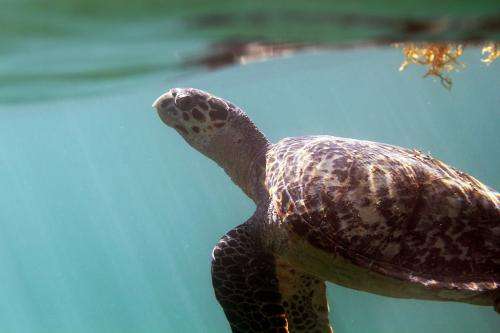Researcher tracks Hawksbill turtles off Brazilian coast

A study of DNA from the critically endangered Hawksbill turtle in Brazilian waters has emphasised the importance of international conservation strategies for their recovery.
UWA's Oceans Institute PhD candidate Julia Reisser is part of a team of researchers that used DNA from young turtles in Brazilian feeding grounds to determine their origin.
Their study, "The Genetic Structure and Natal Origins of Immature Hawksbill Turtles (Eretmochelys imbricata) in Brazilian Waters" is reported in Plos One.
She explains baby turtles travel vast distances over about three years before taking up residency in coastal habitats. They return to the beaches where they were born to lay eggs.
Using their unique genetic signatures researchers found feeding populations in Brazil are connected with rookeries near and far in the Atlantic Ocean, with significant genetic structuring between feeding aggregations off Brazil, Africa, the Gulf of Mexico and Caribbean.
Samples were taken from 157 immature Hawksbills in five areas in Brazilian waters from equatorial to temperate latitudes. This included two skin samples from fore flippers of each turtle. Turtles were hand captured, caught in fishing nets or found stranded on beaches.
In addition, the team performed meta-analysis using new and published genetic data from 2233 turtles sampled at 13 rookeries and 18 feeding grounds located at waters of several countries in the Atlantic Ocean.
Ms Reisser says Hawksbill turtles are in the 'most threatened' category of the International Union for Conservation of Nature's Red List. Millions have been killed for their shell in the last 100 years. Despite international and domestic prohibitions the trade remains a threat.
She says predicting where turtles from different nesting populations go once they leave the beach is essential to their conservation.
"Such information is important to quantify and mitigate the impact of such things as direct harvest, habitat degradation, marine pollution and fisheries by-catch on the different sea turtle nesting populations and sea turtle stocks," she says.
In addition, the researchers identified high correlations between turtle origins estimated through genetic data and oceanographic information.
"This demonstrates that ocean currents have a major influence on the at-sea distribution of Hawksbill turtle populations by shaping the pathways taken by baby turtles," Ms Reisser says.
"Ocean currents transport baby turtles over wide areas and their pathways determine where these animals will recruit to coastal habitats once it is time for them to start their more sedentary coastal stage."
More information: Proietti MC, Reisser J, Marins LF, Rodriguez-Zarate C, Marcovaldi MA, et al. (2014) "Genetic Structure and Natal Origins of Immature Hawksbill Turtles (Eretmochelys imbricata) in Brazilian Waters." PLoS ONE 9(2): e88746. DOI: 10.1371/journal.pone.0088746
Journal information: PLoS ONE
Provided by Science Network WA



















